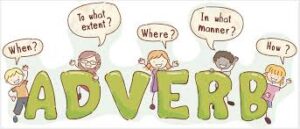Back to: English Language Primary 2
Welcome back to class. Are you good today?
You will be learning Adverbs in this class.
GRAMMATICAL ACCURACY
Introducing Adverbs; Meaning and Examples of Adverbs

What are Adverbs?
They are words used to describe an action, that is verbs.
Verbs are action words like; go, come, run, stand, sleep, hear, talk etc. These actions are then described by words known Adverbs such as quickly, slowly, attentively, fast, soundly, loudly, and so on.
If you were to describe how you ran home from school, you might say I ran home quickly or you say I ran home slowly. Quickly or Slowly describes the action ran.

Let us see how to use adverbs in a sentence.
- I had my bath inside the bathroom
- I did my assignment last week
- My sister got home early
- Muna had his hair cut carefully
- She waited patiently for the food
So, an adverb tells us something more about a verb. It tells us where, how and when an action takes place.
Words like every day, last week, daily, regularly, early, lately are adverbs that tells us when an action happens.
Words like everywhere, inside, outside, top, down, besides, far, behind, back, towards, forward are adverbs that describe where an action takes place.
Words like calmly, slowly, timely, quickly, happily, sadly, roughly, neatly, are adverbs that tells us how an action happens.
More Examples are:
- Scott speaks calmly
- She ate her meal slowly
- I sat behind the house
- I brush my teeth everyday
- Wendy walked in quickly
- Vickie chopped the onions neatly
- Brian sat beside Fred
- The monkey sat at the top of the banana tree
Don’t forget that adverbs only qualify a verb, not a noun while adjectives qualify a noun.
Let us see the difference;
For instance,
a. He drives carefully
b. He is a careful driver
In example a, the word “carefully describes how he drives which is an action. So, carefully is an adverb.
In b, “careful’ describes the noun ‘driver’.
You must ensure you don’t make the mistake.
Again, adverb tells us more about a verb while adjectives describe a noun.
READING
Identification of Mono-syllabic, Bi- syllabic and Multi-syllabic Words.
What is syllable?
Think of anything you can break into two or more than two. Did you think of coconut?
You see, coconut can be broken into many parts, so also words. 
When one split or break sounds of words into parts like coconut, it is referred to as syllable.
Syllable can be one, two, three or more.
Words of one syllable are monosyllabic.
For example:
Cat Dog Ball Cup
Words with two syllables are Bi-syllabic words. This means the sound of the word is broken into two.
For example:
- Apple Ap-ple
- Socket Soc-ket
- Bitter Bit-ter
- London Lon-don
- Express Ex-press
Words with more than two syllables are Multi-syllabic words
For example:
- Africa Af-ri-ca
- Capital Ca-pi-tal
- Domestic Do-mes-tic
- Cucumber Cu-cum-ber
- Survival Sur-vi-val
Quiz
Underline the adverbs in the following sentences.
- Vivian sings beautifully
- Fred sat inside the room.
- The cat ran into the bush.
- I am going there now.
- Will you get me the drink quickly?
In the next class, you will be identifying adverbs in sentence.
See you later.
